The Nguyen Dynasty has different dress regulations for all walks of life, based on the criteria: fabric material, color, sewing, decorative motifs, and even the number of clothes for each class of people also has very strict regulations.
The silk fabrics used to make costumes, crowns for kings and royal family are all high-end goods, ordered by the court in China. The emperors Gia Long and Minh Mang often sent embassies to China to buy parts in the regions of Nanjing and Jiangnan to provide for the needs of royal costumes. In the book Histoire des Relations de la Chine avec l'Annam - Vietnam du XVIe au XIXe siècle, author G. Devéria reflected on an event involving the purchase of silk cloth by Vietnamese envoys when they went to work in China: “The Annamese envoy when passing through Nanjing wanted to buy silk. The Qing dynasty did not oppose this, but because it was a private business, without the recommendation of the Qing dynasty, Chinese merchants raised prices excessively, causing the Annamese envoy to quarrel with them, so the ruling officials had to intervene. From then on, the Qing dynasty demanded that the envoy would have to submit to the authorities a list of items that they wanted to buy. The Chinese officials will have the task of buying goods for the ambassadors. ” However, because the Qing Dynasty did not want to sell yellow silk brocade to the Vietnamese (because they believed that only Chinese emperors could wear yellow robes), from the Thieu Tri dynasty onwards, the Nguyen Dynasty set up silk weaving households in Ha Dong to weave silk and yellow brocade specifically for the court. Traditional silk-weaving households in some other localities are also required to pay for advanced textile items instead of paying taxes with money.
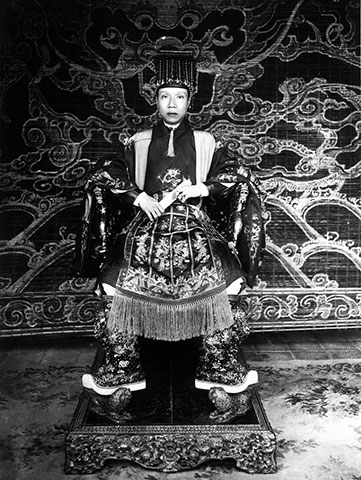
King Khai Dinh wore Te Giao robe, Binh Thien crown, and sat on the throne in the Sacrifice to Heaven ceremony
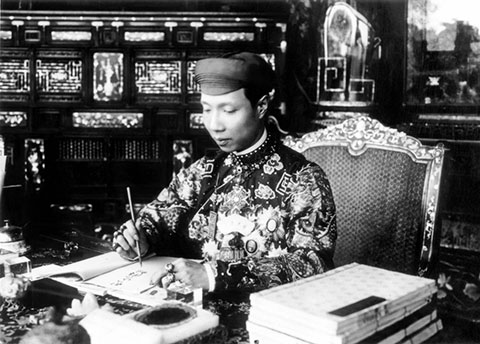
King Khai Dinh costume in his usual court events, head wearing a turban, is working in Can Chanh palace
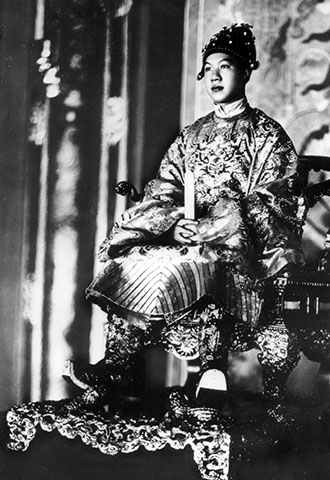
King Bao Dai costume in big court event, head wearing the Nine Dragons crown, sits on the throne in Thai Hoa palace
On the crowns of the kings and queens of the Nguyen Dynasty, gold and silver, pearls, diamonds... were attached to enhance their values and prestige. According to the book of "Ðại Nam hội điển sự lệ", on the hat worn by the king at the end of the dynasty, there were 31 dragons made of fine gold; 30 square flowers with pearls inlaid with 140 diamonds and pearls. The queen's hat has 9 dragons, 9 golden phoenixes, 9 silver basins, 4 silver brooches with 198 pearl beads and 231 crystal beads. The forehead scarf is made of tulle (fabric woven from 8 stranded silk) in Thien Thanh color, inside the yellow lining, 4 fine gold earrings and 4 threads of silk. There were different costumes for different ranks in the Nguyen’s era including the difference in material, color, style, pattern, and accessories. All were set with gold and silver, and with pearls more or less, but each had its own set.
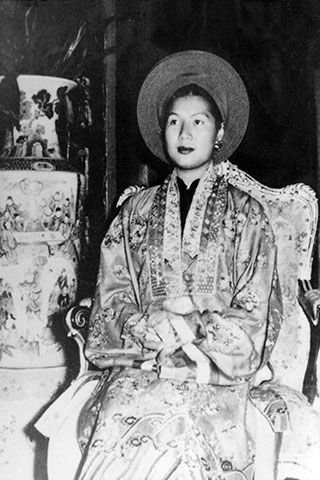
Queen Nam Phuong (Bao Dai's wife) in her usual court dress
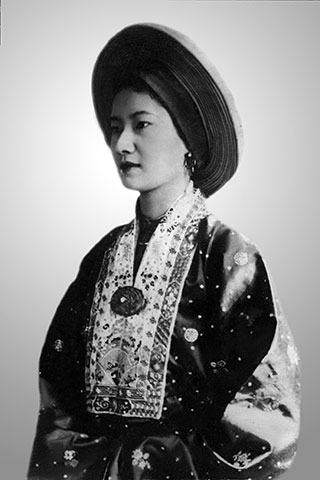
Queen Nam Phuong in her winter costume

Queen Nam Phuong wears a traditional Ao Dai, with Khan Vanh on her head
In terms of decoration, the thematic hierarchy is strictly adhered to. Dragon embroidered king costumes, Qilin embroidered prince costumes, queen costume embroidered flowers and phoenixes (with 3 tail strips), princess costume embroidered phoenixes (like phoenixes but only 1 tail strip). The king's crown for big court events has 9 golden dragons. The Queen Mother's crown is embroidered with only 9 phoenixes; the hat of servants is from 1 phoenix to 7 phoenixes depending on the rank.
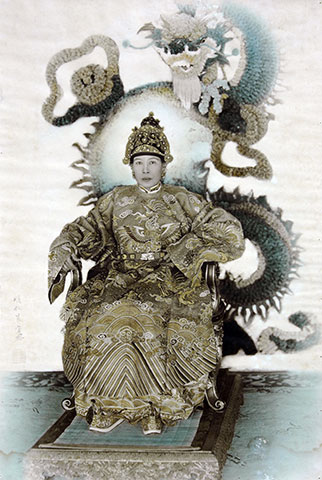
Empress Dowager Doan Huy (wife of Khai Dinh emperor, mother of Bao Dai emperor) in big court events costume
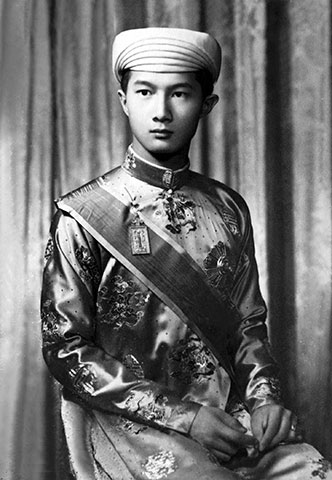
Prince Bao Long (Bao Dai's son) costume with a turban

King Bao Dai, Queen Nam Phuong and Empress Dowager Doan Huy in traditional Ao Dai costumes with Princess Phuong Mai and Phuong Dung
It also has a dragon theme, but the dragon on the king's costume has 5 claws; and the dragon on the prince's costume is just a mask dragon, not decorated with flying dragons or double dragons, and only 4 claws. And if on the king's costume and the queen decorates the dragons with a majestic appearance, then on the royal family costumes are just pythons, or Jiaolong (the lower rank incarnations of the dragon). The costumes of the queen and the queen empress decorate the phoenix pattern (phoenix dancing in a circle), with weaving, and embroidery lines that are very lively and elaborate, on the princess's costumes and servants' costumes phoenix pattern have been reduced, and stylized into birds, the number of treasures attached is also less.
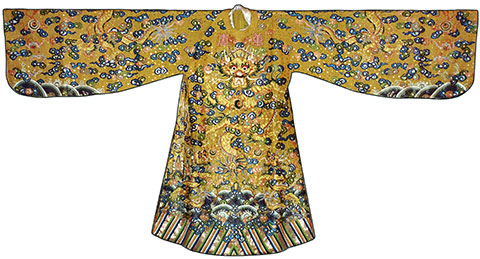
The king's formal court robe, worn during big court events
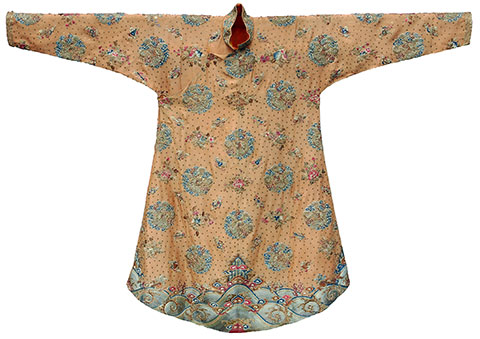
The king's semi-formal court robe, worn during the usual royal court.
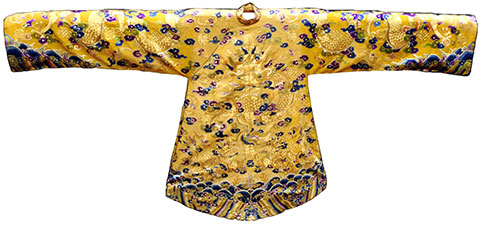
Imperial court rope of the king, worn at ceremonies in temple
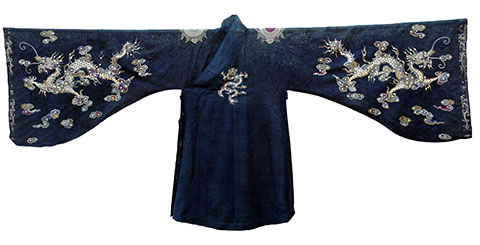
Imperial court rope of the king, worn at Sacrifice to the Nam Giao Ceremony
Only the king and the queen's costume are decorated more in Bat Buu, Tu Thoi patterns, while the costume of the royal family and servants, Bat Buu is replaced by antiques. Even the Chinese characters decorated on the costume also have distinctions. The king's robe often embroidered the words Phuc, Loc, Tho in the style of seal letters, while the words Phuc, Loc, Tho on the women's robe were usually smaller and woven on the fabric surface, not embroidered with pearls or gold necklaces like on the king's costume and often expressed with full stroke letters.

The queen's formal phoenix robe, worn during big court events
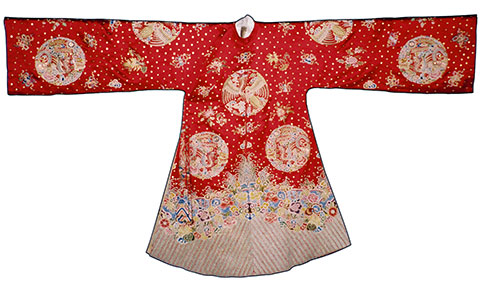
The queen's Nhat Binh robe was worn at the time of the usual court events
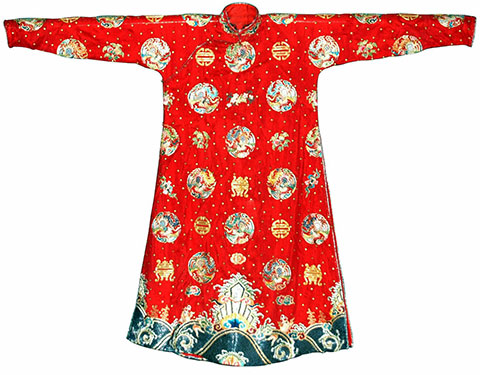
The queen's robe during spring and summer
Strict rules are like that but sometimes there are also very interesting exceptions. The usual court costume of Khai Dinh emperor is currently kept in the Museum of Hue Royal Antiquities, in addition to the usual cloudy dragon and water triangle patterns, there are 18 velvet roses embroidered with gold lines and shiny threads, and two big daisies in front of the chest and behind. On another of the king's robes, there was also a phoenix facing the dragon in a spherical cloud. Khai Dinh Emperor is a man who likes color, likes novelty, and strangeness, not only in clothes but also in the palace, the king's mausoleum, his unique personality also appears in many places where the Thien Dinh Palace is a specific example.
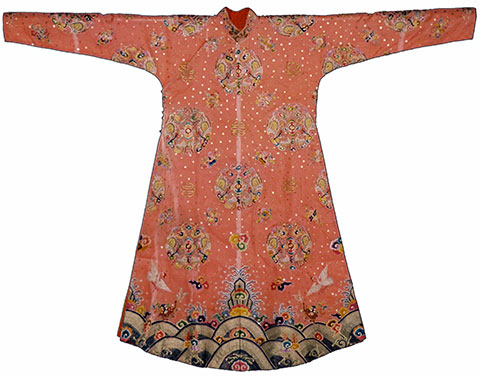
The queen empress's spring costume
The costumes of the Nguyen era also have many types and each type has its own name, its own color and is only worn on specific occasions: big court events costumes; usual court event costumes; ceremonial costumes, casual costumes; spring and summer costumes; autumn and winter costumes...
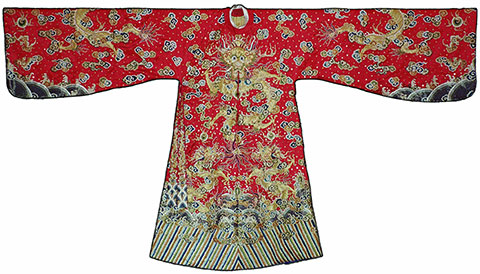
The prince's formal court robe, worn during big court events
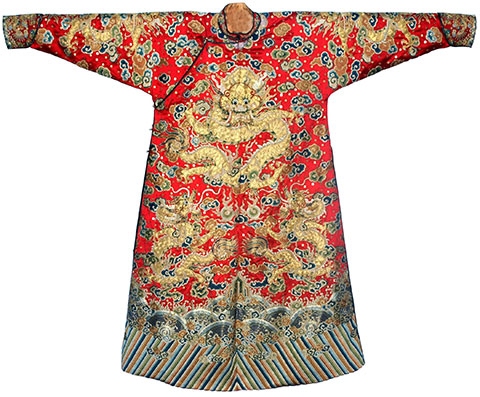
The prince's formal rope, worn during important festive occasions
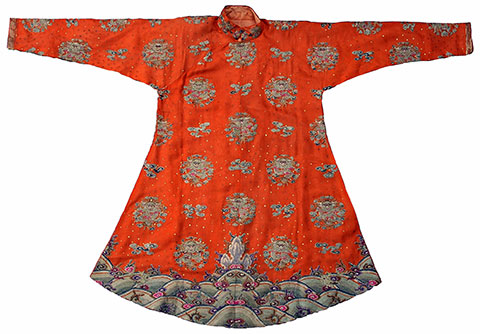
The prince's Sa Kep robe
Each group of costumes includes: robe, crown, belt, undershirt, tablet, socks, shoes... tailor-made in their own way, have their own names and differ in colors and patterns. The king's crown during big court events is called Cuu Long (9-dragon); the shirt is called Long Bao (dragon robe), embroidered with a horizontal dragon shape of 5 claws. Costumes accompanied by dragon robes also have undershirts, belts, jewel tablets, and pairs of dragon shoes embroidered with gold-encrusted glitter. The king's crown during usual court events is called Binh Thien, the robe is called the Hoang Bao, embroidered with dragon, pearls, and gold silk. Accompanying the Hoang Bao are very sophisticated embroidered shoes. The crown used on the occasion of the Nam Giao Ceremony is Mien, the robe is called Con, the color is black, the hands are very large, and embroidered with double dragons along the front two bodies. The robe the king wears in Tich Dien ceremony is a light orange one, embroidered with small dragons hidden in the clouds. Meanwhile, the prince's crown, although very similar to the king's Binh Thien, is called Binh Dinh, to distinguish between classes.
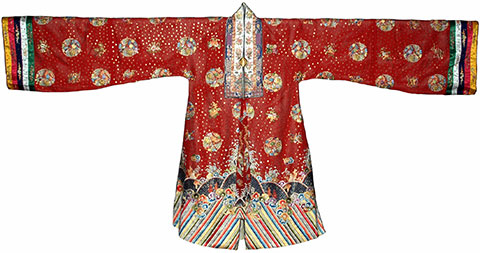
The princess's robe - Nhat Binh
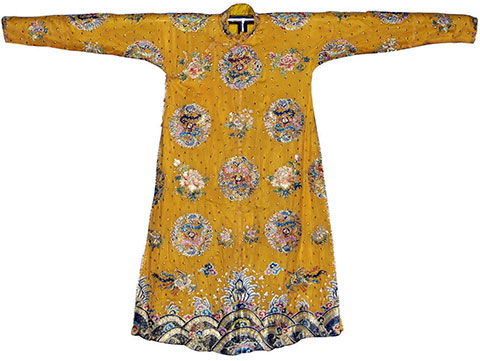
The princess's robe worm during spring and summer
While the costumes of the royal are fussy and cumbersome, the clothes of the people are very simple and are obligatory by the court. The hat is called Phong Can in black color, with no jewelry, the shirt is called Giao Linh also black color, and both socks and shoes are all black. Strangely, in that black costume, everyone was all alike. Still, in the patrols to the countryside, only glimpses of the king knew who was beautiful, and who was ugly to recruit beauties to bring to the forbidden palace to "use" gradually. It turns out that the old saying “Fine feathers make a fine bird” should have been “Beauty is in the eye of the beholder". But the beholder here are the kings of the Nguyen Dynasty, so the royal palace is always full of beautiful women and the vestiges of Tam Cung Luc Vien are still up to now.